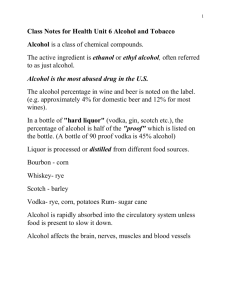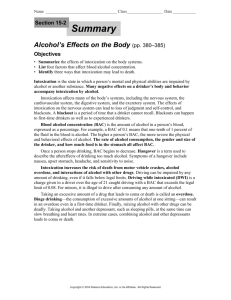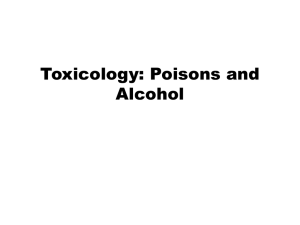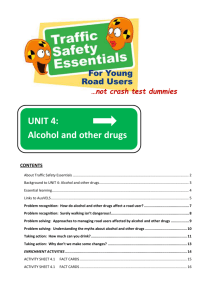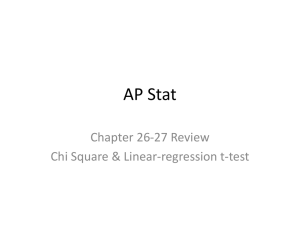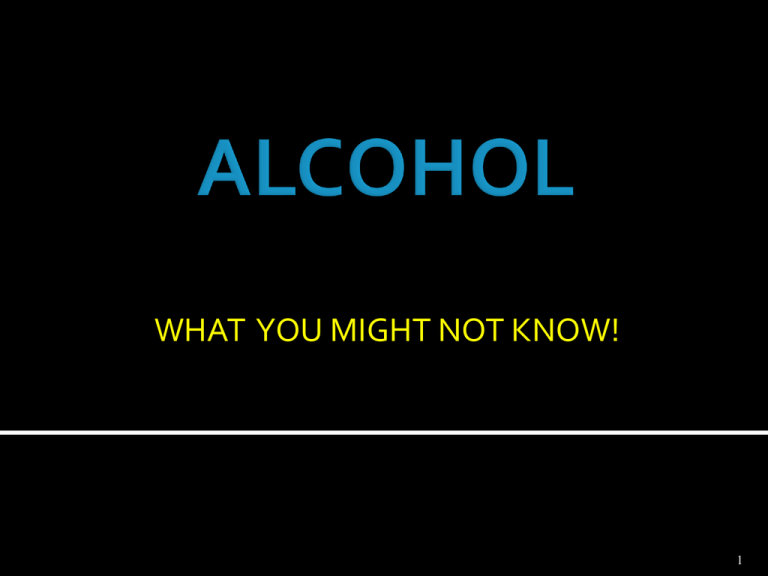
WHAT YOU MIGHT NOT KNOW!
1
Alcohol is a depressant, which means that it SLOWS
the bodies processes.
It is the oldest and most abused drug in history
Alcohol affects many of the body’s organs and slows
their function, including the heart, stomach, liver, and
brain.
It is not just what you drink but how you drink that
affects your level of intoxication: Time, Age, Previous
drinking experiences, and Use of other drugs can all
effect intoxication in UNPREDICTABLE ways.
Only time can cause a person to become sober. The
liver detoxifies ½ ounce of alcohol per hour. No matter
what. Coffee, Red Bull, or a Cold Shower will not help.
ALCOHOL IS ADDICTIVE.
2
Ethanol
or Ethyl Alcohol
*Different beers
have different
alcohol content.
Malt liquor has
higher alcohol
content than
most other
brewed
beverages.
**It is important
to remember
that not all
drinks are
created equal.
Proof is the amount of alcohol in hard liquor. The
percentage of pure alcohol in the hard liquor is one-half
the proof. For example, a 100-proof liquor is about 50%
pure alcohol. Thus, the higher the proof, the more pure
alcohol the hard liquor contains.
Beer, wine, and hard liquor all contain alcohol. The
following common alcoholic drinks contain equal
amounts of alcohol and are often referred to as a drink:
There are many short term affects when or shortly
after consuming alcoholic beverages. Some of
them are…
- Intoxication
- Clumsiness
- Dehydration
- Delayed reflexes
- Slurred speech
- Head aches
- Fainting
- Loss of memory
The long-term toll of heavy drinking is serious.
One of the most serious consequences is for the
liver. In response to long-term alcohol exposure
it starts producing more of, the enzyme which it
uses to break ethanol down. This means, you
need more alcohol for the same effect. This
worsens the addiction. The liver then becomes
over-active, cells die and the tissue hardens. The
result is cirrhosis of the liver. This is a deadly
condition that cannot be reversed.
Other risks of long-term drinking include:
Heart Disease
Stroke
Dementia and brain damage
Myopathy - a weakening of the muscles (and
shrivelled sex organs.)
Cancers related to alcohol include those of
the liver, colon, rectum and breast cancer in
women
How alcohol affects you is
different based on different
absorption rate factors, these
include:
Body Size: The bigger you are, the more
blood you have to dilute the alcohol in
your system. Smaller people are usually
affected more quickly by alcohol than
larger people.
Gender: Women are generally
smaller than men, have a higher
percentage of body fat, and tend to
reach higher BAC’s more quickly.
Mood: A person who is obviously upset,
exhausted, or under a lot of stress may
feel the effects of alcohol more quickly.
Body Composition: In general, the less
you weigh the more quickly alcohol will
be absorbed. However, for people of
the same weight, a person who has
greater muscle mass will absorb alcohol
slower than someone with a higher
percentage of body fat.
Food: A full stomach slows the absorption of
alcohol into the bloodstream. WHY?
Alcohol is a lethal substance. Being knowledgeable about Blood Alcohol Content
will help you understand the effects of varying amounts of alcohol in your system,
and allow you to make informed decisions about drinking.
The standard way of measuring how much alcohol is in the blood stream is Blood
Alcohol Content (BAC) or Blood Alcohol Level (BAL). It can be measured using
blood, saliva, urine or breath and is measured in milligrams of alcohol per 100
milliliters of blood, or milligrams percent.
For Example: A BAC of .10 means one-tenth of 1% or (1/1000) of your total blood
content is alcohol.
MALE
The following is a rough outline of
expected BAC's for a 150 lb. male on
an empty stomach after one hour:
2 drinks
.05 BAC
4 drinks
.10 BAC
FEMALE
The following is a rough outline of
expected BAC's for a 120 lb. female
on an empty stomach after one
hour:
2 drinks
.08 BAC
4 drinks
.17 BAC
.02-.03 % BAC: You are slightly light headed; inhibitions are loosened
.05%-.06 BAC: You’re warm and relaxed; you’re behavior may become exaggerated.
.08-.09% BAC: You are legally drunk; you may start to slur your speech, your sense of
balance is probably off, and your motor skills are becoming impaired.
.10%-.12% BAC: At this level, you feel euphoric, but you lack coordination and
balance; your motor skills are markedly impaired, as are your judgment and
memory.
.14%-.17% BAC: Euphoric feelings may give way to unpleasant feelings; you have
difficulty talking, walking, or even standing; your judgment and perception are
severely impaired.
.20% BAC: You feel confused, dazed, or otherwise disoriented ; at this point you may
experience nausea and/or start vomiting; blackouts are likely.
.25% BAC: All mental, physical, and sensory functions are severely impaired; you're at
increased risk of asphyxiation from choking on vomit and of seriously injuring
yourself by falling or other accidents.
.30% BAC: You have little comprehension of where you are; you may suddenly pass
out --with an alarming BAC like .30%, your body will decide to pass out for you.
.35% BAC: This blood alcohol level is the level of surgical anesthesia; you will
probably stop breathing.
159,000 of today's first-year college students will drop out of school next
year for alcohol related reasons.
One night of heavy drinking can impair your ability to think abstractly for
up to 30 days, limiting your ability to relate textbook reading to what your
teacher says, or to think through a football play.
Alcohol has no food value, It is metabolized by your body into sugar. Even
“skinny” drinks light beers or straight liquor will cause weight gain.
Alcohol takes more water out of the body than it puts in. The harmful
effects of a hangover are mostly a result of severe dehydration. The
headache one might feel after a night of drinking is because your brain has
shrunk away from the sides of your skull BECAUSE IT HAS NO WATER.
Only 20% of the alcohol you swallow is absorbed by the stomach. Most
Alcohol is absorbed into the blood stream through the small intestine. None
of it is digested. Your stomach treats it as a toxin.
Alcohol interferes with the nerve endings that control erections.
Respond to these reasons that someone might give for drinking or not drinking
My parents say NO
To have fun
I don’t like the taste
To not feel left out
I’m afraid of losing control
Just to try it
I’ll get kicked off the team
To be sociable
I’m too young
To calm down
I’ve seen the damage it can do
I’m thirsty
I’d rather spend my money other
To fit in
ways
To forget my problems It makes me sick
It’s illegal
To relax
Everyone else is doing If I get caught it can mess up my
future
it
It’s dangerous
11


